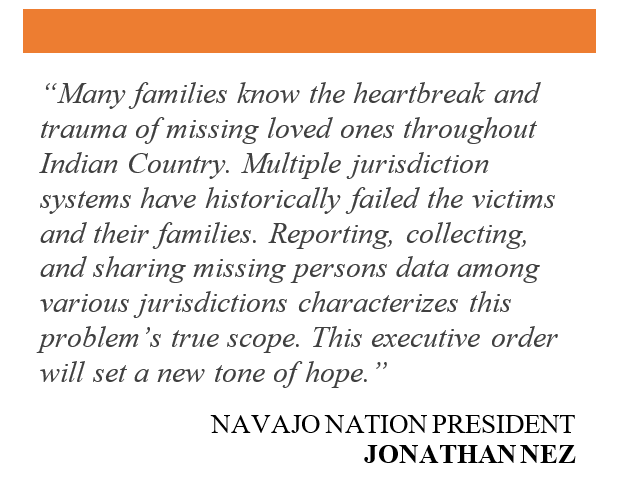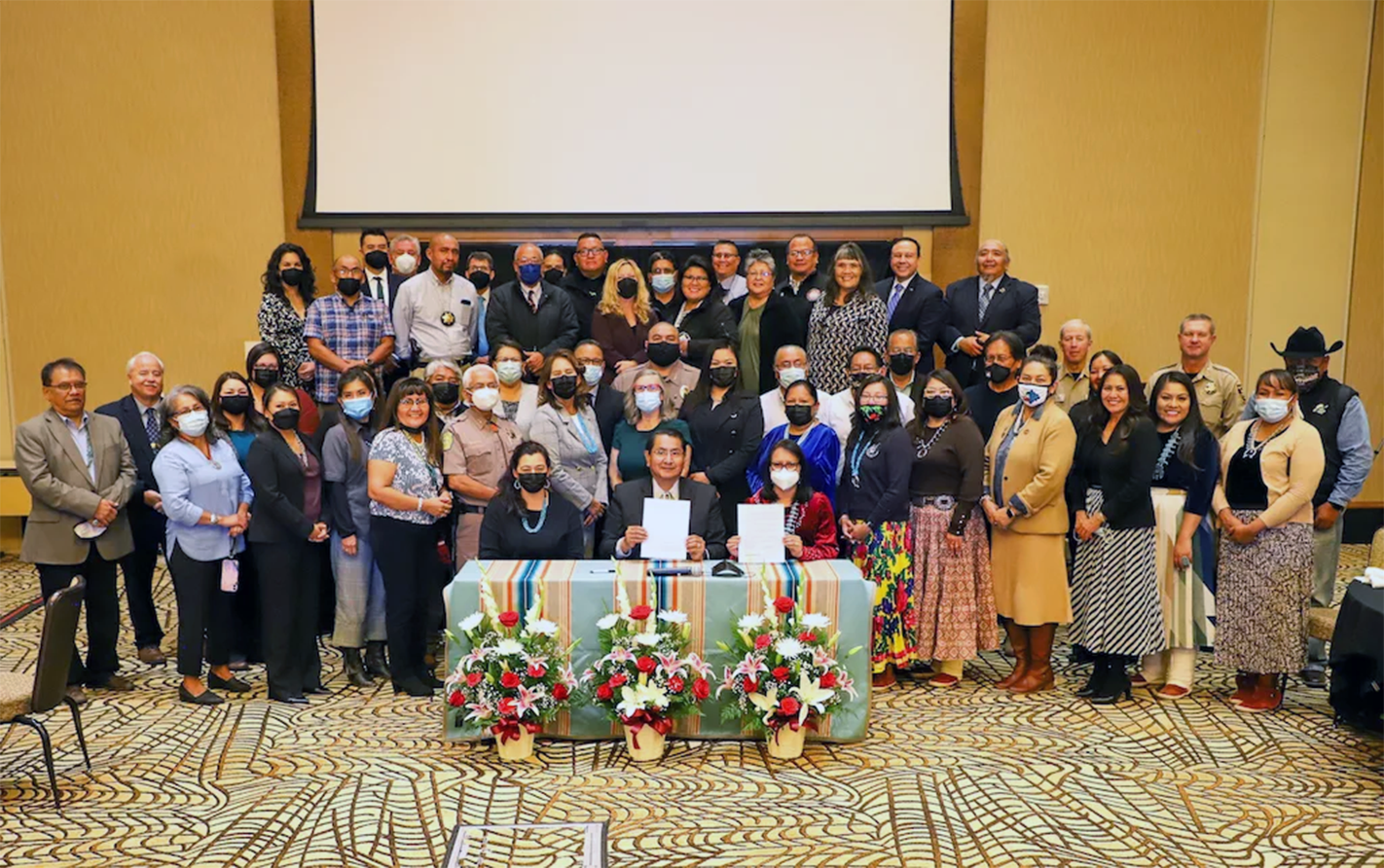The Navajo Nation has issued a ground-breaking executive order to investigate and locate missing Navajo persons in a manner that is empathetic to victims and their families.
On Monday, October 24, Navajo Nation President Jonathan Nez and First Lady Phefelia Nez were joined by Navajo Nation Police Chief Darryl Noon, Navajo Nation Executive Branch division directors, representatives from U.S. Attorney’s Offices in Arizona, New Mexico, and Utah, and members of the Federal Bureau of Investigation (FBI), to adopt and implement the Nihí K’éi dóó Béédahoozinígíí Náalkaa Bikégó Naaltsoos – “The Navajo Nation Guidelines for Missing Persons.”
“The Navajo Nation Guidelines for Missing Persons” is a component of the national Tribal Community Response Plan (TCRP), established by the U.S. Office of the Attorney General to help find missing persons and heal victims and families.
“The plan will guide the Navajo Nation and its local, state, and federal partners to build response capacity, collaboration, and support for missing persons and their loved ones,” said Navajo Nation member Tyesha Wood, Program Manager for the National Criminal Justice Training Center’s AMBER Alert in Indian Country initiative.
The plan includes four components – law enforcement response, victim support services, media strategies, and the integration of community-based resources – “that will help local, state, and federal law enforcement and social service agencies to work together to bring missing loved ones home,” President Nez explained. “The purpose is to reunite, restore, and heal our families and communities.” 
Under the leadership of President Nez and First Lady Nez, the Navajo Nation executive branch, in partnership with local, state, and federal counterparts, have established a systemic response to Navajo families’ call for justice. The efforts will recognize Navajo Nation laws while pioneering a new era of cooperation between the Navajo Nation, U.S. Attorneys Offices, and the FBI.
“Historically, investigation and prosecution of Navajo Nation missing persons cases have been entrusted to the FBI and U.S. Attorney’s Offices due to potential violations of federal laws. Unfortunately, such deference to federal agencies has often resulted in Navajo families being kept in the dark and their cases not prosecuted,” said First Lady Nez.
“The Navajo Nation Guidelines for Missing Persons” asserts that any missing person case on the Navajo Nation is a potential violation of Navajo Nation law and should be treated as such. “There is need for proactivity, collaboration, and support within the justice and public safety systems to protect our people,” said First Lady Nez. “Our hope is that working together will heal, restore, and reunite families.”
The Tribal Community Response Plan maintains that any missing person case impacts K’é (kinship, harmony, and balance) and should involve the victim’s immediate family, relatives, and community. TCRP committee leaders, including Navajo Nation Police Chief Noon, Criminal Investigation Director Michael Henderson, Chief Prosecutor Vernon Jackson, Emergency Management Director Harland Cleveland, Division of Social Services Executive Director Deannah Neswood-Gishey, and Department of Behavioral and Mental Health Services Director Dr. Michelle Brandser, developed guidelines that coordinate Navajo Nation law enforcement and victim service response to serve the best interest of victims and their families.
“The Nihí K’éi dóó Béédahoozinígíí Náalkaa Bikégó Naaltsoos also engages non-tribal partners and agencies in a collaborative response plan and map of the entire criminal justice landscape that Navajo victims and their families must navigate from their first emergency call through the ultimate resolution of a case,” said President Nez. “Most importantly, it will guide the Navajo Nation and its partners to build response capacity, collaboration, and support for missing persons and their loved ones.”
The executive order will initiate implementation of these guidelines within the Navajo Nation Division of Public Safety, Navajo Nation Department of Justice, Navajo Nation Division of Social Services, and Navajo Department of Health, which includes the training of all Navajo Nation employees within divisions and departments that share responsibility for missing person cases on the Navajo Nation.
“Creating this plan was a tremendous undertaking for all internal and external partners because it considered the entire Navajo Nation’s 27,413 square mile land base. As the largest land base tribe in the country, the Navajo Nation’s TCRP required extensive collaboration with more partners than any similar plan in Indian Country.”
Non-tribal stakeholders include U.S. Attorney’s Offices; the FBI; multiple public safety agencies within Arizona, Utah, and New Mexico; sheriffs and emergency responders in 13 counties; and local police departments in neighboring cities and towns. “Overall, we are grateful for all partners for their involvement in bringing our loved ones home,” said First Lady Nez.
The TCRP is part of the U.S. Attorney General’s Missing and Murdered Indigenous Persons (MMIP) Initiative, and the Navajo Nation is among the first of 11 Tribal Community Response Plan pilot sites in Indian Country, including tribes in Arizona, New Mexico, Montana, Oklahoma, Michigan, Utah, Nevada, Minnesota, Oregon, Washington, and Alaska.
Read the Navajo Nation press release here.
Photo courtesy of the Navajo Nation: Navajo Nation President Jonathan Nez, First Lady Phefelia Nez, Navajo Nation Executive Branch division directors, and members of the Federal Bureau of Investigation and U.S. Attorney’s Offices in Arizona, New Mexico, and Utah, gathered for the executive order signing at the Twin Arrows Navajo Casino Resort on October 24, 2022.

